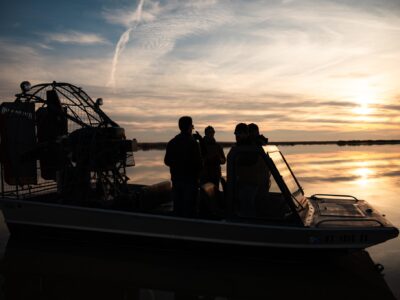The era of clean energy is here, and it’s here to stay. According to the International Energy Agency, investments in zero-carbon energy technologies like wind, solar, and electric vehicles (EVs) are expected to double that of fossil fuels like oil, coal, and natural gas in 2024.
New startups, technologies, and innovations geared toward sustainable and renewable energy are popping up all across the globe all the time. And for good reason: climate change can’t be solved by just a few individuals.
Fortunately, there’s been a rise in policies protecting the planet, investments in sustainable infrastructure, and the amount of eco-conscious corporations. What’s even more promising is that this new era of sustainability is still just getting started. As with all things, some of the current clean energy projects in development will be more impactful than others. More importantly, for this article, some of these projects are definitely bigger than others.
In honor of the wave of renewable energy innovation, keep reading to learn about three of the world’s latest and largest clean energy projects.
The World’s Largest Tidal Power Project

Photo Courtesy Liverpool City Region Combined Authority
Liverpool, England, is well known for many things, including its unmistakable Scouse accent. The city is the home of Liverpool FC, the most-watched Premier League football (soccer) club globally last season. It’s also the hometown of The Beatles, whose 20(!) No. 1 hits on the Billboard Hot 100 still hold the record. However, the more than 800-year-old city could soon add another, more eco-oriented staple to its lineup: Mersey Tidal Power.
Situated on the Mersey River, the project would become the largest tidal power generator in the world if constructed, powering more than 1 million homes for over 120 years.
The plan has been talked about for decades, but it seems it’s finally in motion, with the city recently unveiling detailed plans for the massive tidal range facility. The dam-like Mersey Tidal Power would act as a barrier between the Irish Sea and a tidal basin, creating power from the wind turbines that will be built across it and the tidal power generated from the basin.
The project would connect Liverpool with the Wirral Peninsula, locally known as the Wirral, opening up a new route for pedestrians and cyclists wanting to travel between the two areas. Liverpool’s Mersey Tidal Power proposal is still years away from fruition, but it seems a lot more likely than the first time plans for the project came about some 100 years ago, according to News Atlas.
A Humongous Sand Battery

Photo Courtesy Polar Night Energy
A six-and-a-half-hour flight headed Northwest of the Mersey Tidal Power site would end up pretty close (in a very approximate sense) to a small town in southern Finland called Pornainen. While the Finnish municipality with roughly 5,000 residents doesn’t sport the same level of popular football clubs and celebrities as Liverpool, it does have a “world’s largest clean energy” project of its own, which is much closer to the finish line.
Innovative renewables company Polar Night Energy has developed what will be the biggest ever sand battery on the planet when it’s launched within the next year.
In essence, sand batteries charge low-grade sand stored in silo-like structures with heat generated from excess wind and solar electricity.
Polar Night’s industrial-sized thermal energy storage units aren’t completely uncharted waters for the firm. The company deployed a smaller model of the sand battery by rigging it to a power station in the town of Kankaanpää in May 2022. The older version, while not nearly as large as the newer prototype currently under construction, successfully provided a source of renewable energy for the town.
The project, expected to reduce Pornainen’s carbon emissions by almost 70%, represents an exciting next step forward for a type of renewable energy many haven’t heard of yet. A few more of these steps could very well change that last statement.
The Planet’s Biggest Clean Energy Plant

Photo Courtesy Pete Linforth
Indian multinational conglomerate the Adani Group was founded in 1988 to trade commodities. The company has grown significantly since then by becoming India’s biggest coal miner and importer, among other commodities. The Adani Group’s clean energy arm, Adani Green Energy Limited (AGEL), is currently constructing what it says will be the largest energy plant in the world.
Five times the size of Paris, visible from outer space, and capable of electrifying an entire country (not India, it’s too big), the $20 billion solar and wind power plant is expected to be finished in approximately five years.
The Khavda Renewable Energy Park will take up more than 200 square miles, and it’s not the only clean energy investment the company has in mind.
AGEL executive director Sagar Adani — whose last name might sound familiar because he’s the nephew of Adani Group founder and multi-billionaire Gautam Adani — spoke on the need for ambitious plans like this plant to speed up the world’s most populous country’s clean energy transition.
“There is no choice for India but to start doing things at a previously unimagined size and scale,” Adani said in an interview with CNN.
What’s Next?
If there’s one takeaway from the entire history of humankind, it’s that we — yes, a human is behind these words and would be more than happy to crush a Captcha test to prove it — have always, and will always, be driven to build big things. This article attempts to showcase a few modern-day examples of what those things are, but, in truth, there’s a high probability that one, or even all, of these four projects will soon be surpassed by even larger (or stronger) designs.
If you disagree with the notion that humans love to build big things, I’ll leave you with a question. What makes the majority of the Seven Wonders of the Ancient World so special if not their size and scale?





